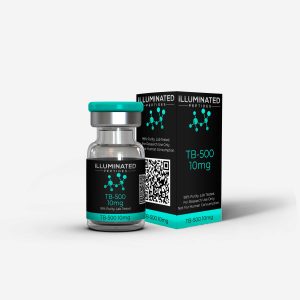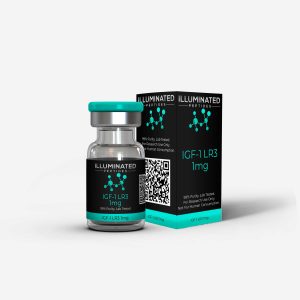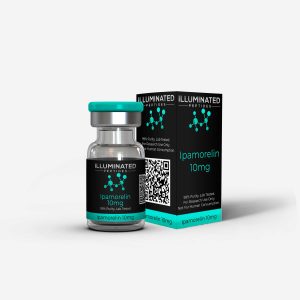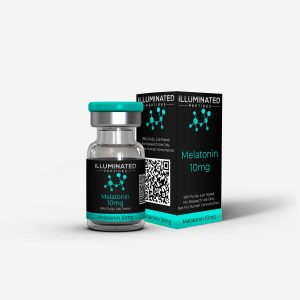Description
What is Sermorelin?
Sermorelin, also known as GRF 1-29, is a synthetic peptide originally derived as a shortened analog of growth hormone–releasing hormone (GHRH). Unlike compounds that directly supply growth hormone, Sermorelin works by stimulating receptors in the pituitary gland responsible for natural growth hormone production. Specifically, it functions as an agonist of the GHRH receptor.
Research shows that Sermorelin can influence growth hormone release and has been investigated in clinical studies for its role in promoting pituitary function. Beyond its primary focus on growth hormone pathways, it has also been studied for potential applications related to metabolism, tissue repair, and overall endocrine regulation. These findings make it a peptide of considerable scientific interest.
Sermorelin Structure
Sequence: H-Tyr-Ala-Asp-Ala-Ile-Phe-Thr-Asn-Ser-Tyr-Arg-Lys-Val-Leu-Gly-Gln-Leu-Ser-Ala-Arg-Lys-Leu-Leu-Gln-Asp-Ile-Met-Ser-Arg-NH₂
Molecular Formula: C₁₄₉H₂₄₆N₄₄O₄₂S
Molecular Weight: 3357.9 g/mol
PubChem CID: 16132397
CAS Number: 86168-78-7
Sermorelin Research
Sermorelin and Growth Hormone Secretion
Sermorelin is most widely recognized for its role in stimulating natural growth hormone release. Unlike synthetic growth hormone administration, which provides an external supply, Sermorelin activates growth hormone–releasing hormone (GHRH) receptors in the pituitary gland, encouraging the body to produce its own hormone. This mechanism allows researchers to study endocrine pathways that regulate development, repair, and metabolism.
Clinical investigations have demonstrated that Sermorelin can increase pulsatile growth hormone secretion. These findings have been especially relevant in models of age-related decline, where pituitary responsiveness is reduced. By engaging central endocrine signaling, Sermorelin provides a more physiologic approach to growth hormone modulation, offering insight into how the hypothalamic–pituitary axis maintains hormonal balance.
What makes Sermorelin unique compared to direct growth hormone administration is its selectivity. Instead of bypassing natural controls, it works within the body’s feedback mechanisms, allowing researchers to examine adaptive responses and long-term regulation. This distinction positions Sermorelin as a compound of particular scientific interest in studies of hormonal homeostasis.
Sermorelin and Metabolism
Beyond growth hormone stimulation, Sermorelin has been explored for its impact on metabolic processes. Research indicates that growth hormone release can influence fat metabolism, lean body mass preservation, and glucose handling. As a result, Sermorelin has been used in studies investigating how endocrine modulation may affect weight balance and energy utilization.
Some investigations have focused on age-related metabolic slowdown, where declining hormone levels contribute to shifts in body composition. By stimulating endogenous growth hormone, Sermorelin allows researchers to examine whether restoring more youthful signaling patterns influences fat distribution, muscle recovery, or metabolic efficiency.
This line of research also extends into studies of insulin sensitivity and glucose regulation. Since growth hormone interacts closely with carbohydrate metabolism, Sermorelin offers an experimental tool for evaluating these mechanisms in controlled laboratory settings.
Sermorelin and Tissue Repair
A growing area of research examines Sermorelin’s potential role in tissue repair and recovery. Growth hormone is known to stimulate the production of insulin-like growth factor 1 (IGF-1), a peptide linked to cell regeneration and collagen synthesis. By indirectly raising IGF-1 through growth hormone release, Sermorelin has been used experimentally to study wound healing and connective tissue resilience.
Preclinical research suggests that increased IGF-1 activity may support bone density maintenance, joint recovery, and muscle repair. These findings highlight Sermorelin’s value in laboratory models of injury recovery and degenerative conditions.
In addition, its ability to promote natural hormone cycles—rather than continuous hormone exposure—provides a more controlled approach to studying repair mechanisms without overwhelming feedback systems.
Sermorelin and Neuroendocrine Function
Sermorelin research has also extended into neuroendocrine health. Since growth hormone production is regulated by the hypothalamus and pituitary, the peptide provides a window into understanding how the brain communicates with endocrine glands.
Studies suggest that Sermorelin may help evaluate pituitary responsiveness in conditions where hormone release is impaired. Researchers have used it diagnostically to assess whether the pituitary can still respond to GHRH stimulation. This application has made Sermorelin a valuable tool in differentiating between hypothalamic and pituitary dysfunction in laboratory settings.





